2012 FORD SUPER DUTY change time
[x] Cancel search: change timePage 58 of 93
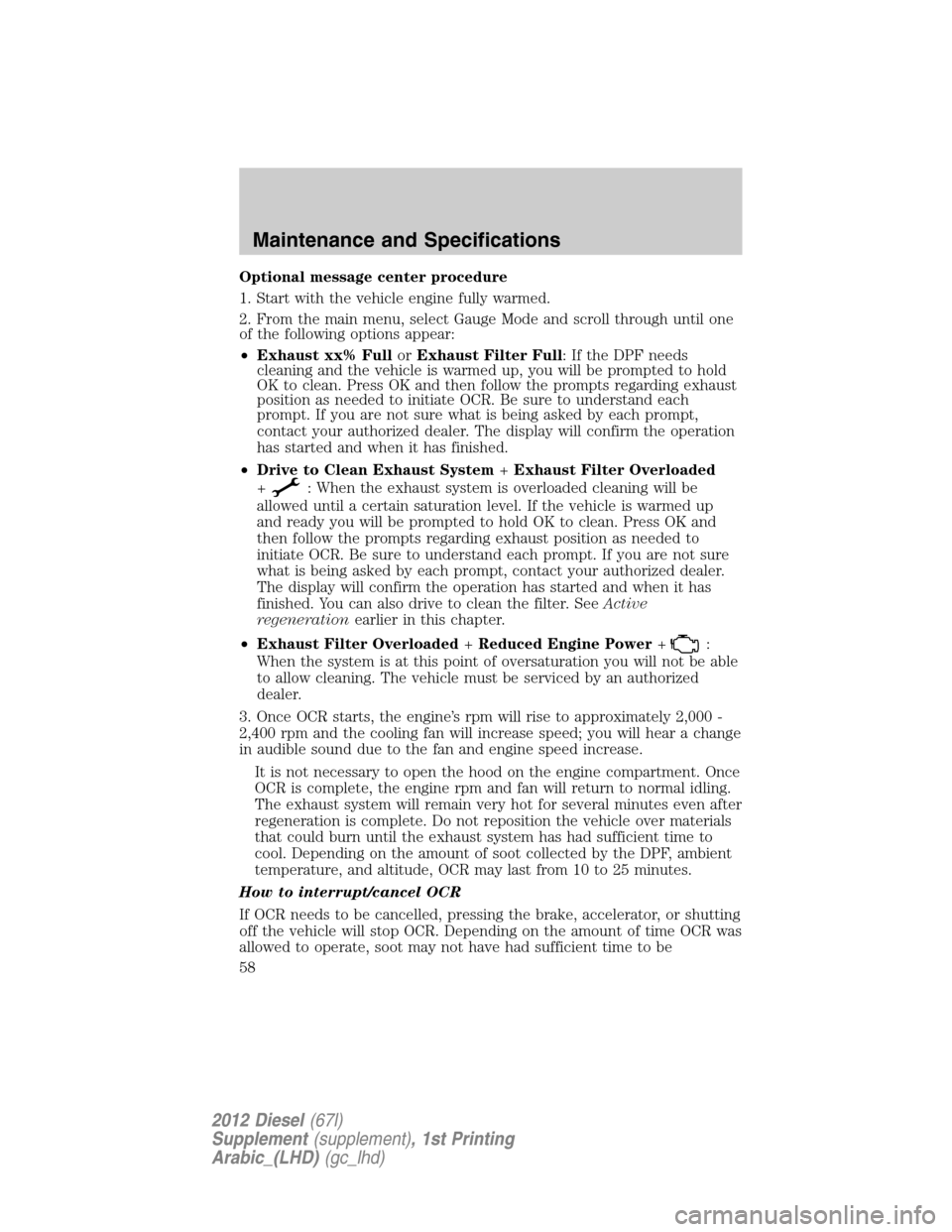
Optional message center procedure
1. Start with the vehicle engine fully warmed.
2. From the main menu, select Gauge Mode and scroll through until one
of the following options appear:
•Exhaust xx% FullorExhaust Filter Full: If the DPF needs
cleaning and the vehicle is warmed up, you will be prompted to hold
OK to clean. Press OK and then follow the prompts regarding exhaust
position as needed to initiate OCR. Be sure to understand each
prompt. If you are not sure what is being asked by each prompt,
contact your authorized dealer. The display will confirm the operation
has started and when it has finished.
•Drive to Clean Exhaust System+Exhaust Filter Overloaded
+
: When the exhaust system is overloaded cleaning will be
allowed until a certain saturation level. If the vehicle is warmed up
and ready you will be prompted to hold OK to clean. Press OK and
then follow the prompts regarding exhaust position as needed to
initiate OCR. Be sure to understand each prompt. If you are not sure
what is being asked by each prompt, contact your authorized dealer.
The display will confirm the operation has started and when it has
finished. You can also drive to clean the filter. SeeActive
regenerationearlier in this chapter.
•Exhaust Filter Overloaded+Reduced Engine Power+
:
When the system is at this point of oversaturation you will not be able
to allow cleaning. The vehicle must be serviced by an authorized
dealer.
3. Once OCR starts, the engine’s rpm will rise to approximately 2,000 -
2,400 rpm and the cooling fan will increase speed; you will hear a change
in audible sound due to the fan and engine speed increase.
It is not necessary to open the hood on the engine compartment. Once
OCR is complete, the engine rpm and fan will return to normal idling.
The exhaust system will remain very hot for several minutes even after
regeneration is complete. Do not reposition the vehicle over materials
that could burn until the exhaust system has had sufficient time to
cool. Depending on the amount of soot collected by the DPF, ambient
temperature, and altitude, OCR may last from 10 to 25 minutes.
How to interrupt/cancel OCR
If OCR needs to be cancelled, pressing the brake, accelerator, or shutting
off the vehicle will stop OCR. Depending on the amount of time OCR was
allowed to operate, soot may not have had sufficient time to be
Maintenance and Specifications
58
2012 Diesel(67l)
Supplement(supplement), 1st Printing
Arabic_(LHD)(gc_lhd)
Page 62 of 93
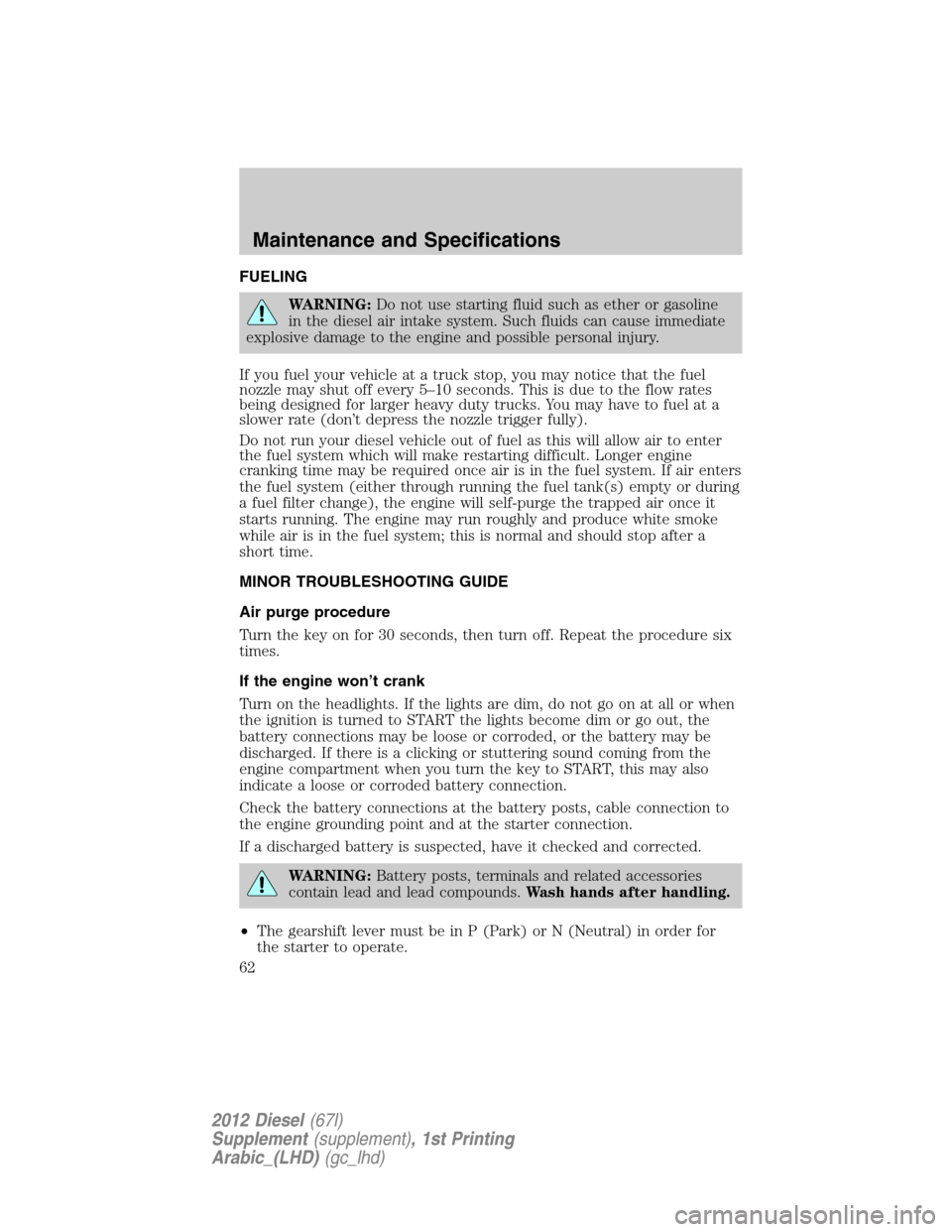
FUELING
WARNING:Do not use starting fluid such as ether or gasoline
in the diesel air intake system. Such fluids can cause immediate
explosive damage to the engine and possible personal injury.
If you fuel your vehicle at a truck stop, you may notice that the fuel
nozzle may shut off every 5–10 seconds. This is due to the flow rates
being designed for larger heavy duty trucks. You may have to fuel at a
slower rate (don’t depress the nozzle trigger fully).
Do not run your diesel vehicle out of fuel as this will allow air to enter
the fuel system which will make restarting difficult. Longer engine
cranking time may be required once air is in the fuel system. If air enters
the fuel system (either through running the fuel tank(s) empty or during
a fuel filter change), the engine will self-purge the trapped air once it
starts running. The engine may run roughly and produce white smoke
while air is in the fuel system; this is normal and should stop after a
short time.
MINOR TROUBLESHOOTING GUIDE
Air purge procedure
Turn the key on for 30 seconds, then turn off. Repeat the procedure six
times.
If the engine won’t crank
Turn on the headlights. If the lights are dim, do not go on at all or when
the ignition is turned to START the lights become dim or go out, the
battery connections may be loose or corroded, or the battery may be
discharged. If there is a clicking or stuttering sound coming from the
engine compartment when you turn the key to START, this may also
indicate a loose or corroded battery connection.
Check the battery connections at the battery posts, cable connection to
the engine grounding point and at the starter connection.
If a discharged battery is suspected, have it checked and corrected.
WARNING:Battery posts, terminals and related accessories
contain lead and lead compounds.Wash hands after handling.
•The gearshift lever must be in P (Park) or N (Neutral) in order for
the starter to operate.
Maintenance and Specifications
62
2012 Diesel(67l)
Supplement(supplement), 1st Printing
Arabic_(LHD)(gc_lhd)
Page 68 of 93
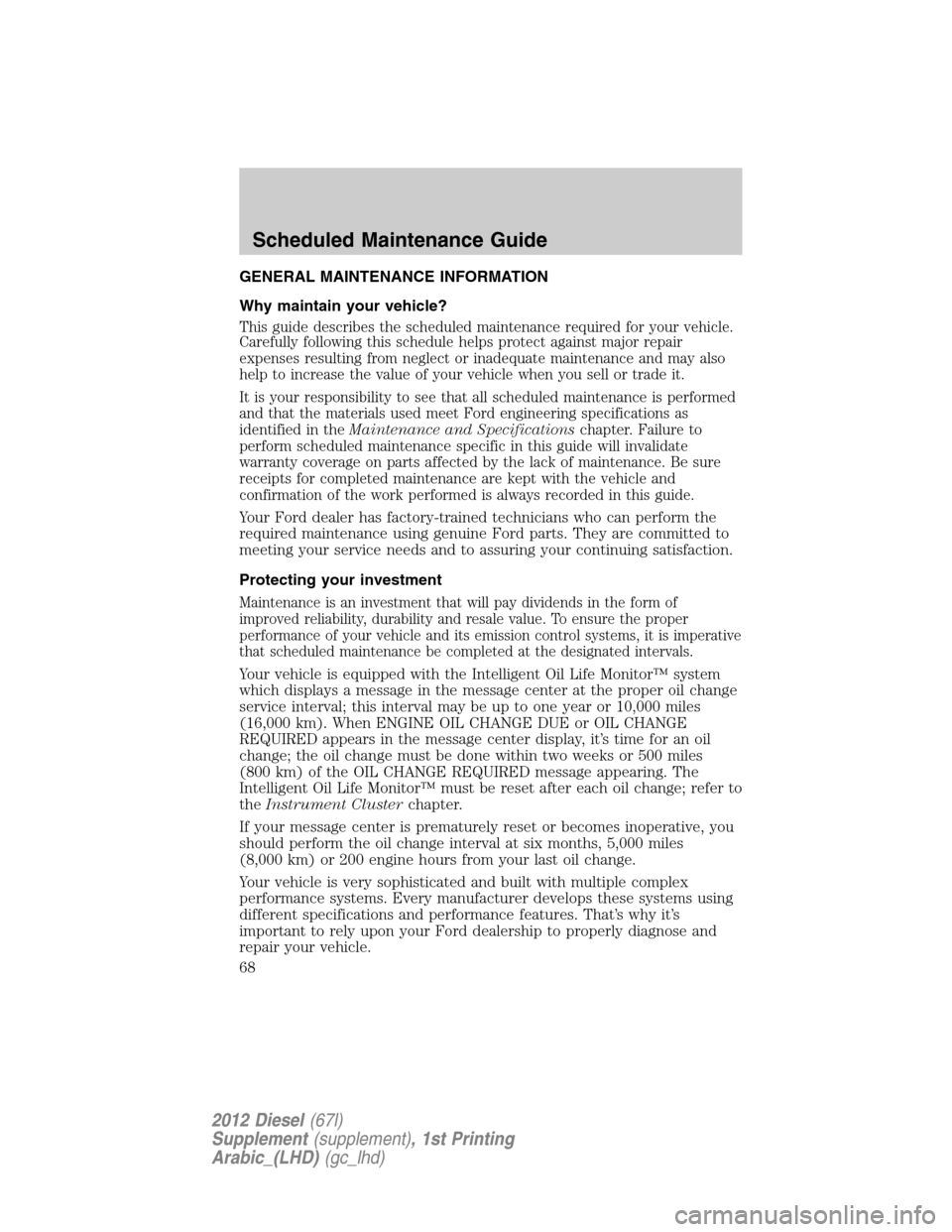
GENERAL MAINTENANCE INFORMATION
Why maintain your vehicle?
This guide describes the scheduled maintenance required for your vehicle.
Carefully following this schedule helps protect against major repair
expenses resulting from neglect or inadequate maintenance and may also
help to increase the value of your vehicle when you sell or trade it.
It is your responsibility to see that all scheduled maintenance is performed
and that the materials used meet Ford engineering specifications as
identified in theMaintenance and Specificationschapter. Failure to
perform scheduled maintenance specific in this guide will invalidate
warranty coverage on parts affected by the lack of maintenance. Be sure
receipts for completed maintenance are kept with the vehicle and
confirmation of the work performed is always recorded in this guide.
Your Ford dealer has factory-trained technicians who can perform the
required maintenance using genuine Ford parts. They are committed to
meeting your service needs and to assuring your continuing satisfaction.
Protecting your investment
Maintenance is an investment that will pay dividends in the form of
improved reliability, durability and resale value. To ensure the proper
performance of your vehicle and its emission control systems, it is imperative
that scheduled maintenance be completed at the designated intervals.
Your vehicle is equipped with the Intelligent Oil Life Monitor™ system
which displays a message in the message center at the proper oil change
service interval; this interval may be up to one year or 10,000 miles
(16,000 km). When ENGINE OIL CHANGE DUE or OIL CHANGE
REQUIRED appears in the message center display, it’s time for an oil
change; the oil change must be done within two weeks or 500 miles
(800 km) of the OIL CHANGE REQUIRED message appearing. The
Intelligent Oil Life Monitor™ must be reset after each oil change; refer to
theInstrument Clusterchapter.
If your message center is prematurely reset or becomes inoperative, you
should perform the oil change interval at six months, 5,000 miles
(8,000 km) or 200 engine hours from your last oil change.
Your vehicle is very sophisticated and built with multiple complex
performance systems. Every manufacturer develops these systems using
different specifications and performance features. That’s why it’s
important to rely upon your Ford dealership to properly diagnose and
repair your vehicle.
Scheduled Maintenance Guide
68
2012 Diesel(67l)
Supplement(supplement), 1st Printing
Arabic_(LHD)(gc_lhd)
Page 73 of 93
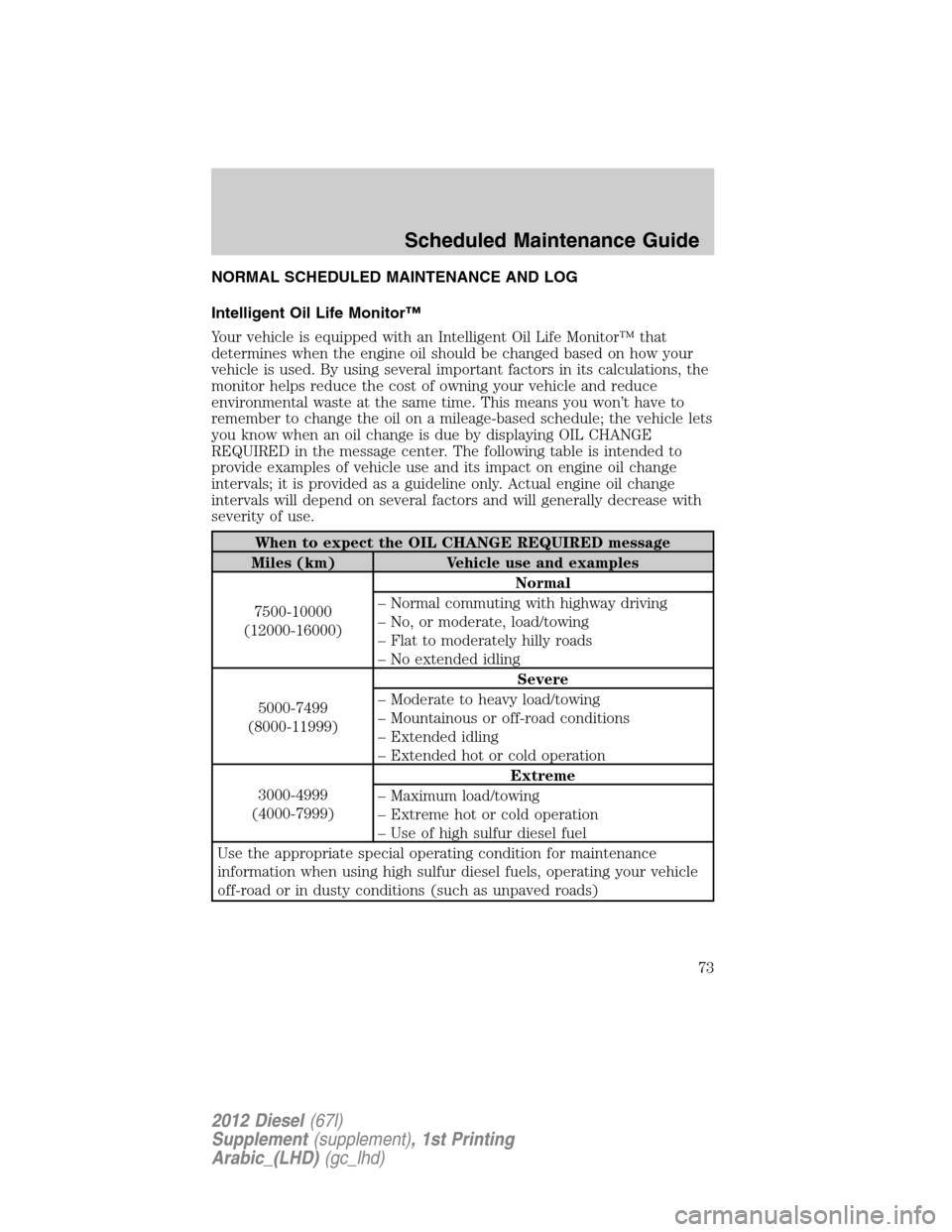
NORMAL SCHEDULED MAINTENANCE AND LOG
Intelligent Oil Life Monitor™
Your vehicle is equipped with an Intelligent Oil Life Monitor™ that
determines when the engine oil should be changed based on how your
vehicle is used. By using several important factors in its calculations, the
monitor helps reduce the cost of owning your vehicle and reduce
environmental waste at the same time. This means you won’t have to
remember to change the oil on a mileage-based schedule; the vehicle lets
you know when an oil change is due by displaying OIL CHANGE
REQUIRED in the message center. The following table is intended to
provide examples of vehicle use and its impact on engine oil change
intervals; it is provided as a guideline only. Actual engine oil change
intervals will depend on several factors and will generally decrease with
severity of use.
When to expect the OIL CHANGE REQUIRED message
Miles (km) Vehicle use and examples
7500-10000
(12000-16000)Normal
– Normal commuting with highway driving
– No, or moderate, load/towing
– Flat to moderately hilly roads
– No extended idling
5000-7499
(8000-11999)Severe
– Moderate to heavy load/towing
– Mountainous or off-road conditions
– Extended idling
– Extended hot or cold operation
3000-4999
(4000-7999)Extreme
– Maximum load/towing
– Extreme hot or cold operation
– Use of high sulfur diesel fuel
Use the appropriate special operating condition for maintenance
information when using high sulfur diesel fuels, operating your vehicle
off-road or in dusty conditions (such as unpaved roads)
Scheduled Maintenance Guide
73
2012 Diesel(67l)
Supplement(supplement), 1st Printing
Arabic_(LHD)(gc_lhd)
Page 80 of 93
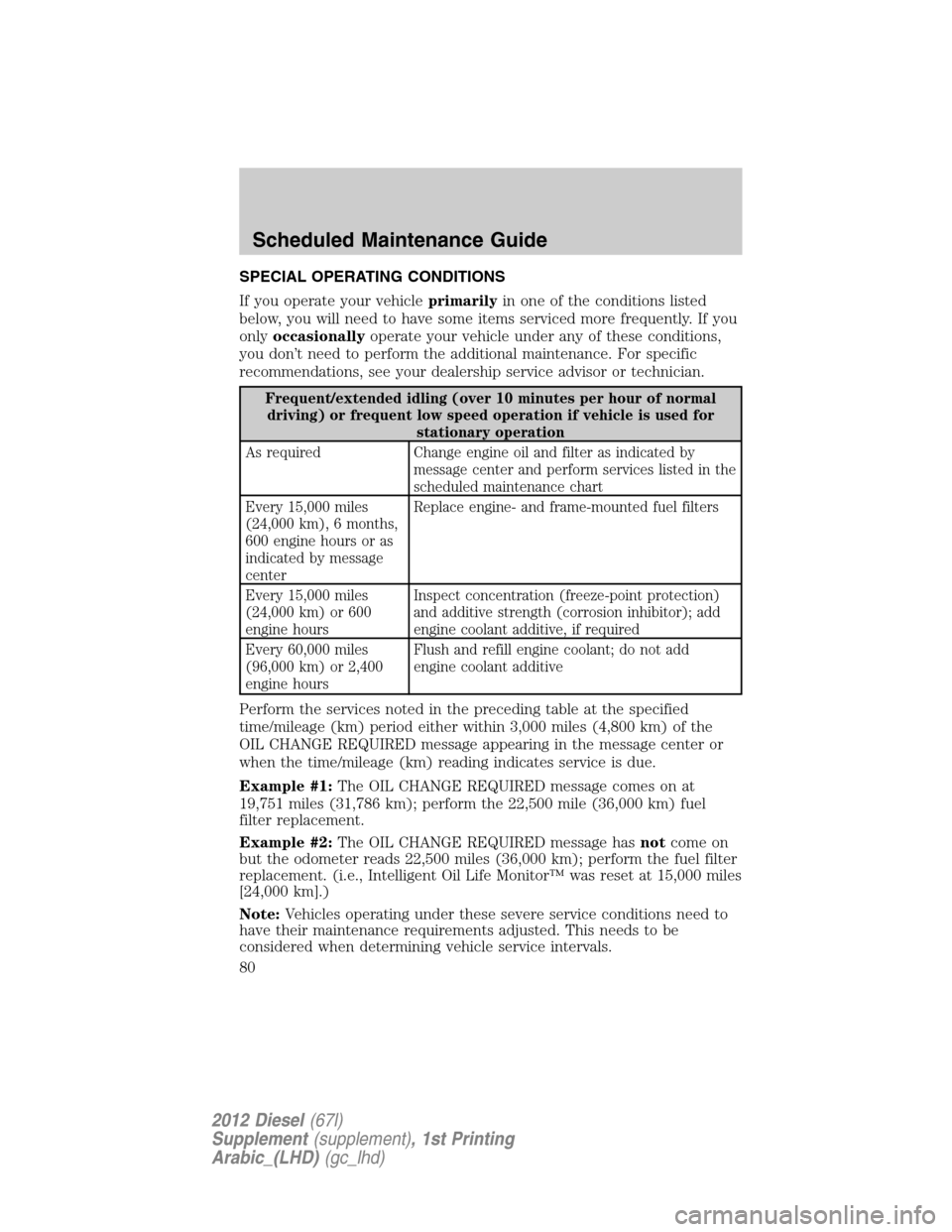
SPECIAL OPERATING CONDITIONS
If you operate your vehicleprimarilyin one of the conditions listed
below, you will need to have some items serviced more frequently. If you
onlyoccasionallyoperate your vehicle under any of these conditions,
you don’t need to perform the additional maintenance. For specific
recommendations, see your dealership service advisor or technician.
Frequent/extended idling (over 10 minutes per hour of normal
driving) or frequent low speed operation if vehicle is used for
stationary operation
As required Change engine oil and filter as indicated by
message center and perform services listed in the
scheduled maintenance chart
Every 15,000 miles
(24,000 km), 6 months,
600 engine hours or as
indicated by message
centerReplace engine- and frame-mounted fuel filters
Every 15,000 miles
(24,000 km) or 600
engine hoursInspect concentration (freeze-point protection)
and additive strength (corrosion inhibitor); add
engine coolant additive, if required
Every 60,000 miles
(96,000 km) or 2,400
engine hoursFlush and refill engine coolant; do not add
engine coolant additive
Perform the services noted in the preceding table at the specified
time/mileage (km) period either within 3,000 miles (4,800 km) of the
OIL CHANGE REQUIRED message appearing in the message center or
when the time/mileage (km) reading indicates service is due.
Example #1:The OIL CHANGE REQUIRED message comes on at
19,751 miles (31,786 km); perform the 22,500 mile (36,000 km) fuel
filter replacement.
Example #2:The OIL CHANGE REQUIRED message hasnotcome on
but the odometer reads 22,500 miles (36,000 km); perform the fuel filter
replacement. (i.e., Intelligent Oil Life Monitor™ was reset at 15,000 miles
[24,000 km].)
Note:Vehicles operating under these severe service conditions need to
have their maintenance requirements adjusted. This needs to be
considered when determining vehicle service intervals.
Scheduled Maintenance Guide
80
2012 Diesel(67l)
Supplement(supplement), 1st Printing
Arabic_(LHD)(gc_lhd)
Page 81 of 93
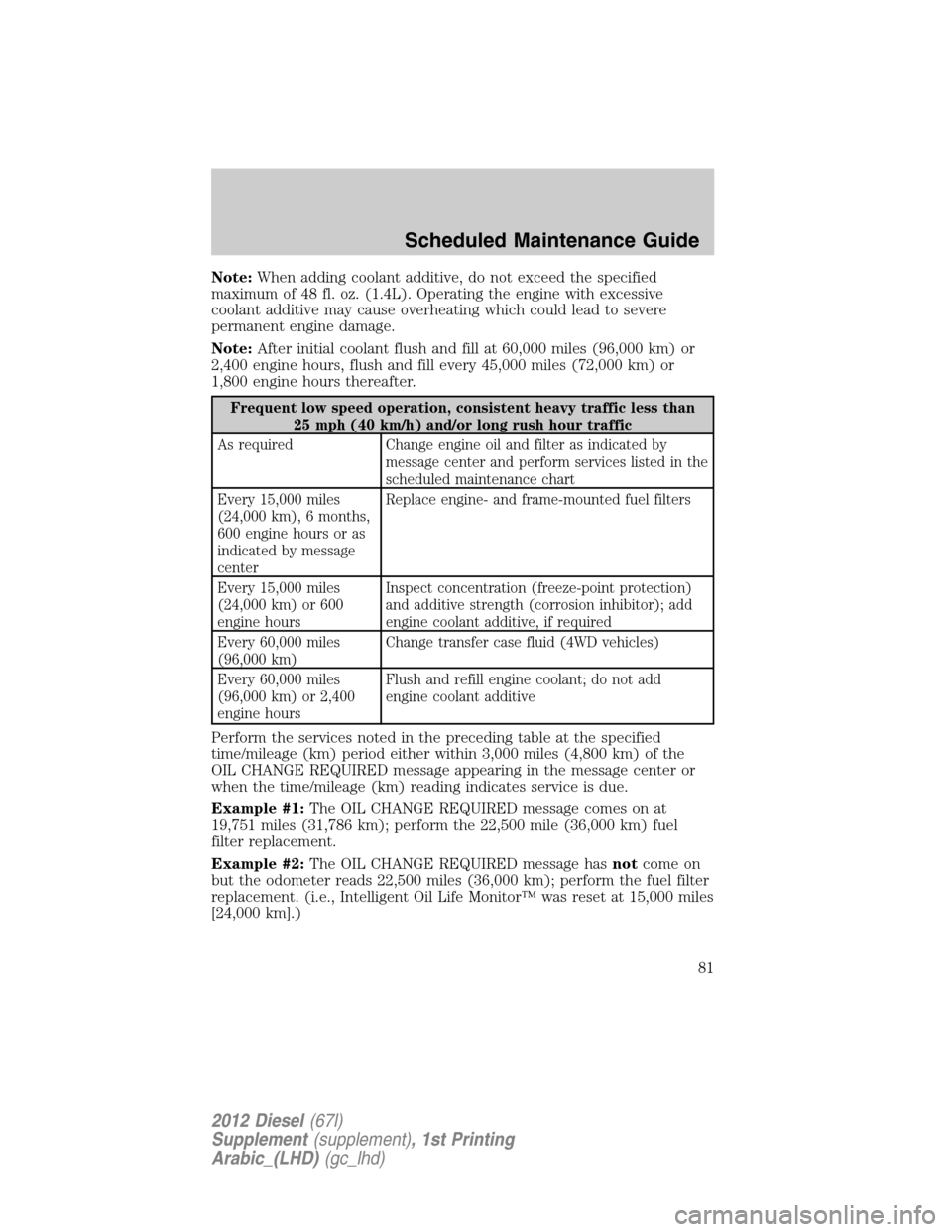
Note:When adding coolant additive, do not exceed the specified
maximum of 48 fl. oz. (1.4L). Operating the engine with excessive
coolant additive may cause overheating which could lead to severe
permanent engine damage.
Note:After initial coolant flush and fill at 60,000 miles (96,000 km) or
2,400 engine hours, flush and fill every 45,000 miles (72,000 km) or
1,800 engine hours thereafter.
Frequent low speed operation, consistent heavy traffic less than
25 mph (40 km/h) and/or long rush hour traffic
As required Change engine oil and filter as indicated by
message center and perform services listed in the
scheduled maintenance chart
Every 15,000 miles
(24,000 km), 6 months,
600 engine hours or as
indicated by message
centerReplace engine- and frame-mounted fuel filters
Every 15,000 miles
(24,000 km) or 600
engine hoursInspect concentration (freeze-point protection)
and additive strength (corrosion inhibitor); add
engine coolant additive, if required
Every 60,000 miles
(96,000 km)Change transfer case fluid (4WD vehicles)
Every 60,000 miles
(96,000 km) or 2,400
engine hoursFlush and refill engine coolant; do not add
engine coolant additive
Perform the services noted in the preceding table at the specified
time/mileage (km) period either within 3,000 miles (4,800 km) of the
OIL CHANGE REQUIRED message appearing in the message center or
when the time/mileage (km) reading indicates service is due.
Example #1:The OIL CHANGE REQUIRED message comes on at
19,751 miles (31,786 km); perform the 22,500 mile (36,000 km) fuel
filter replacement.
Example #2:The OIL CHANGE REQUIRED message hasnotcome on
but the odometer reads 22,500 miles (36,000 km); perform the fuel filter
replacement. (i.e., Intelligent Oil Life Monitor™ was reset at 15,000 miles
[24,000 km].)
Scheduled Maintenance Guide
81
2012 Diesel(67l)
Supplement(supplement), 1st Printing
Arabic_(LHD)(gc_lhd)
Page 82 of 93
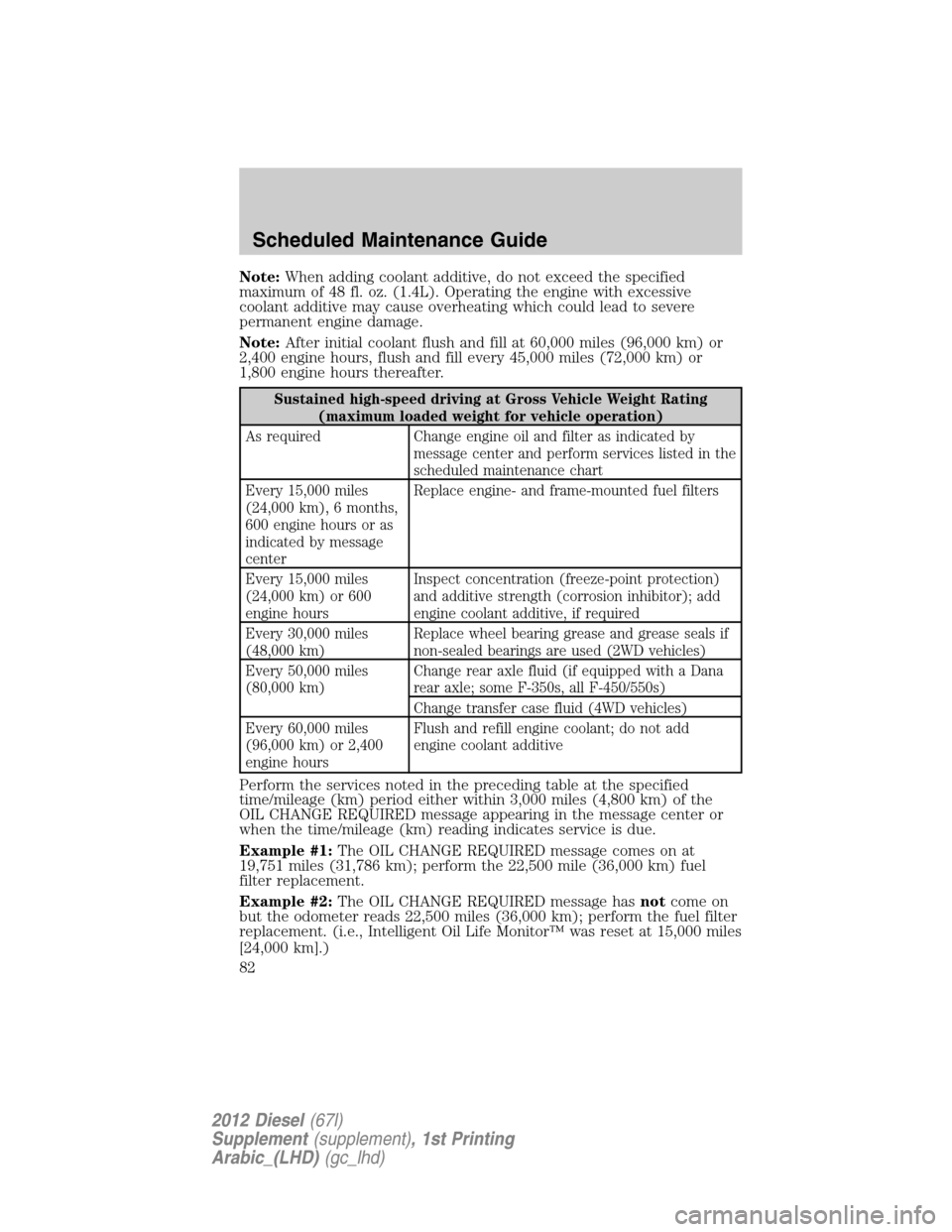
Note:When adding coolant additive, do not exceed the specified
maximum of 48 fl. oz. (1.4L). Operating the engine with excessive
coolant additive may cause overheating which could lead to severe
permanent engine damage.
Note:After initial coolant flush and fill at 60,000 miles (96,000 km) or
2,400 engine hours, flush and fill every 45,000 miles (72,000 km) or
1,800 engine hours thereafter.
Sustained high-speed driving at Gross Vehicle Weight Rating
(maximum loaded weight for vehicle operation)
As required Change engine oil and filter as indicated by
message center and perform services listed in the
scheduled maintenance chart
Every 15,000 miles
(24,000 km), 6 months,
600 engine hours or as
indicated by message
centerReplace engine- and frame-mounted fuel filters
Every 15,000 miles
(24,000 km) or 600
engine hoursInspect concentration (freeze-point protection)
and additive strength (corrosion inhibitor); add
engine coolant additive, if required
Every 30,000 miles
(48,000 km)Replace wheel bearing grease and grease seals if
non-sealed bearings are used (2WD vehicles)
Every 50,000 miles
(80,000 km)Change rear axle fluid (if equipped with a Dana
rear axle; some F-350s, all F-450/550s)
Change transfer case fluid (4WD vehicles)
Every 60,000 miles
(96,000 km) or 2,400
engine hoursFlush and refill engine coolant; do not add
engine coolant additive
Perform the services noted in the preceding table at the specified
time/mileage (km) period either within 3,000 miles (4,800 km) of the
OIL CHANGE REQUIRED message appearing in the message center or
when the time/mileage (km) reading indicates service is due.
Example #1:The OIL CHANGE REQUIRED message comes on at
19,751 miles (31,786 km); perform the 22,500 mile (36,000 km) fuel
filter replacement.
Example #2:The OIL CHANGE REQUIRED message hasnotcome on
but the odometer reads 22,500 miles (36,000 km); perform the fuel filter
replacement. (i.e., Intelligent Oil Life Monitor™ was reset at 15,000 miles
[24,000 km].)
Scheduled Maintenance Guide
82
2012 Diesel(67l)
Supplement(supplement), 1st Printing
Arabic_(LHD)(gc_lhd)
Page 83 of 93
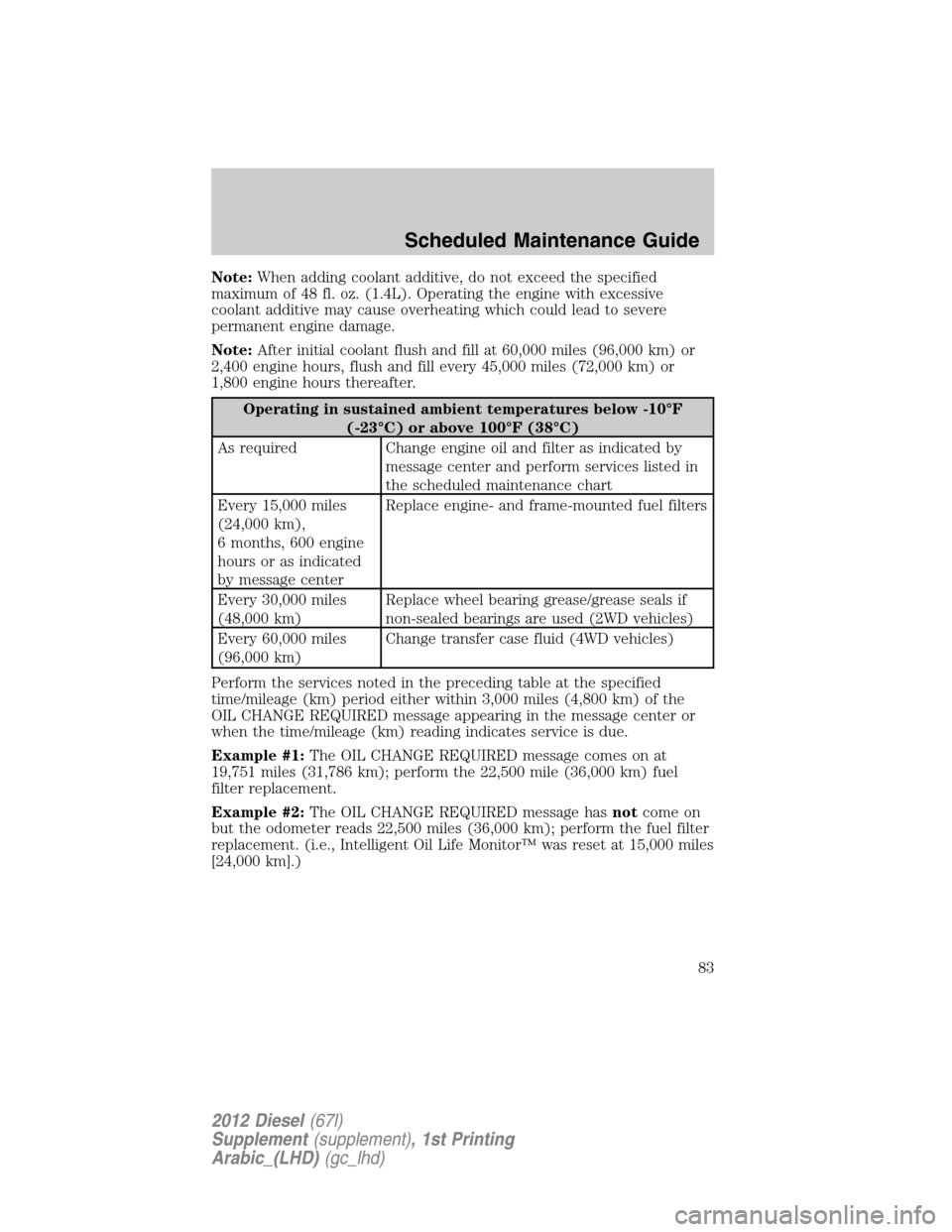
Note:When adding coolant additive, do not exceed the specified
maximum of 48 fl. oz. (1.4L). Operating the engine with excessive
coolant additive may cause overheating which could lead to severe
permanent engine damage.
Note:After initial coolant flush and fill at 60,000 miles (96,000 km) or
2,400 engine hours, flush and fill every 45,000 miles (72,000 km) or
1,800 engine hours thereafter.
Operating in sustained ambient temperatures below -10°F
(-23°C) or above 100°F (38°C)
As required Change engine oil and filter as indicated by
message center and perform services listed in
the scheduled maintenance chart
Every 15,000 miles
(24,000 km),
6 months, 600 engine
hours or as indicated
by message centerReplace engine- and frame-mounted fuel filters
Every 30,000 miles
(48,000 km)Replace wheel bearing grease/grease seals if
non-sealed bearings are used (2WD vehicles)
Every 60,000 miles
(96,000 km)Change transfer case fluid (4WD vehicles)
Perform the services noted in the preceding table at the specified
time/mileage (km) period either within 3,000 miles (4,800 km) of the
OIL CHANGE REQUIRED message appearing in the message center or
when the time/mileage (km) reading indicates service is due.
Example #1:The OIL CHANGE REQUIRED message comes on at
19,751 miles (31,786 km); perform the 22,500 mile (36,000 km) fuel
filter replacement.
Example #2:The OIL CHANGE REQUIRED message hasnotcome on
but the odometer reads 22,500 miles (36,000 km); perform the fuel filter
replacement. (i.e., Intelligent Oil Life Monitor™ was reset at 15,000 miles
[24,000 km].)
Scheduled Maintenance Guide
83
2012 Diesel(67l)
Supplement(supplement), 1st Printing
Arabic_(LHD)(gc_lhd)